 Technology peripherals
Technology peripherals
 AI
AI
 The effect reaches 96% of the OpenAI model of the same scale, and it is open source upon release! The domestic team releases a new large model, and the CEO goes to the battle to write code
The effect reaches 96% of the OpenAI model of the same scale, and it is open source upon release! The domestic team releases a new large model, and the CEO goes to the battle to write code
The effect reaches 96% of the OpenAI model of the same scale, and it is open source upon release! The domestic team releases a new large model, and the CEO goes to the battle to write code
Jun 07, 2023 pm 02:20 PMDomestic self-developed large models welcome new faces, and they are open source as soon as they are released!
The latest news is that the multi-modal large language model TigerBot has been officially unveiled, including two versions of 7 billion parameters and 180 billion parameters, both open source.
The dialogue AI supported by this model is launched simultaneously.
Writing slogans, making forms, and correcting grammatical errors are all very effective; it also supports multi-modality and can generate pictures.

The evaluation results show that TigerBot-7B has reached 96% of the comprehensive performance of OpenAI models of the same size.
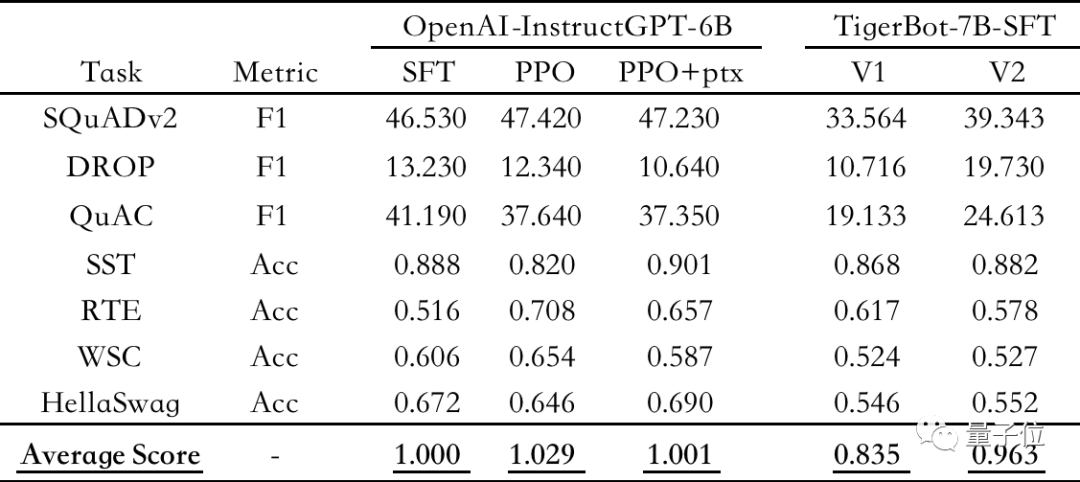
△Automatic evaluation on public NLP data sets, using OpenAI-instruct GPT-6B-SFT as the benchmark, normalizing and averaging each model The score of
and the larger-scale TigerBot-180B may be the largest-scale large language model currently open source in the industry.
In addition, the team also open sourced 100G pre-training data and supervised fine-tuning of 1G or 1 million pieces of data.
Based on TigerBot, developers can create their own large models in half a day.
Currently, TigerBot Dialogue AI has been invited for internal testing, and the open source code data has been uploaded to GitHub (see the end of the article for detailed links).

These important tasks come from a small team of only 5 people at the beginning. The chief programmer & scientist is the CEO himself.
But this team is by no means unknown.
Since 2017, they have started their business in the field of NLP, specializing in vertical field search. is best at the financial field where data is heavy, and has had in-depth cooperation with Founder Securities, Guosen Securities, etc.
Founder and CEO, has more than 20 years of experience in the industry. He was a visiting professor at UC Berkeley and holds 3 best conference papers and 10 technology patents.
Now, they are determined to move from specialized areas to general-purpose large models.
And we started with the lowest basic model from the beginning, completed 3,000 experimental iterations within 3 months, and we still have the confidence to open source the phased results to the outside world.
People can’t help but wonder, who are they? What do you want to do? What phased results have been achieved so far?
What is TigerBot?
Specifically, TigerBot is a large domestic self-developed multi-language task model.
Covers 15 major categories of capabilities such as generation, open question and answer, programming, drawing, translation, and brainstorming, and supports more than 60 subtasks.
And supports plug-in function, which allows the model to be networked and obtain more fresh data and information.
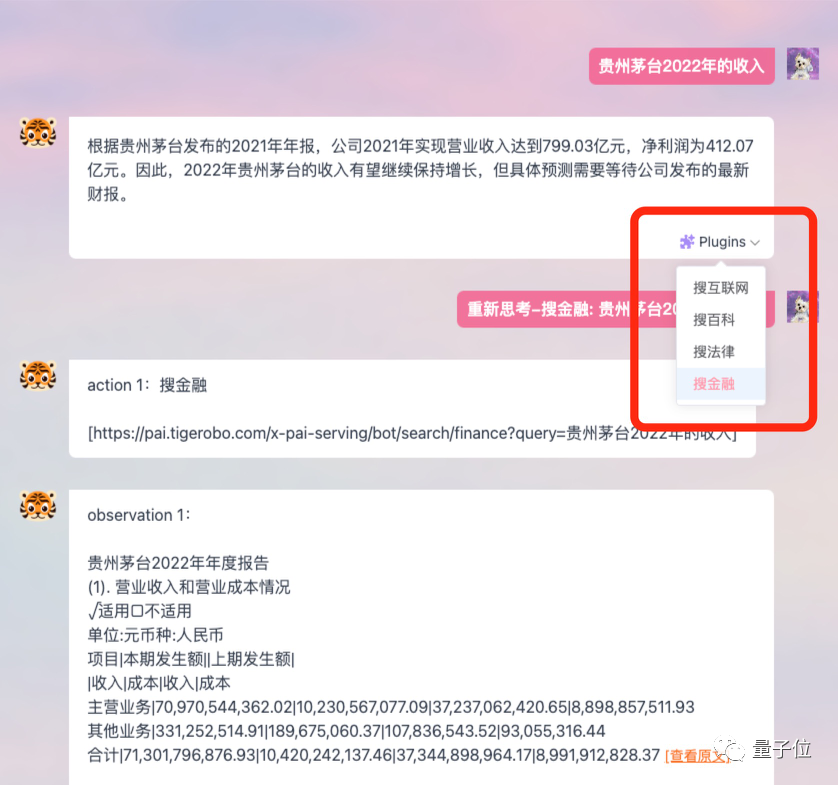
Its positioning is more biased toward office scenes, and it proposes the goal of improving people's workflow and increasing efficiency.
For example, let it help me write a news flash about Apple Vision Pro, and the effect is similar:
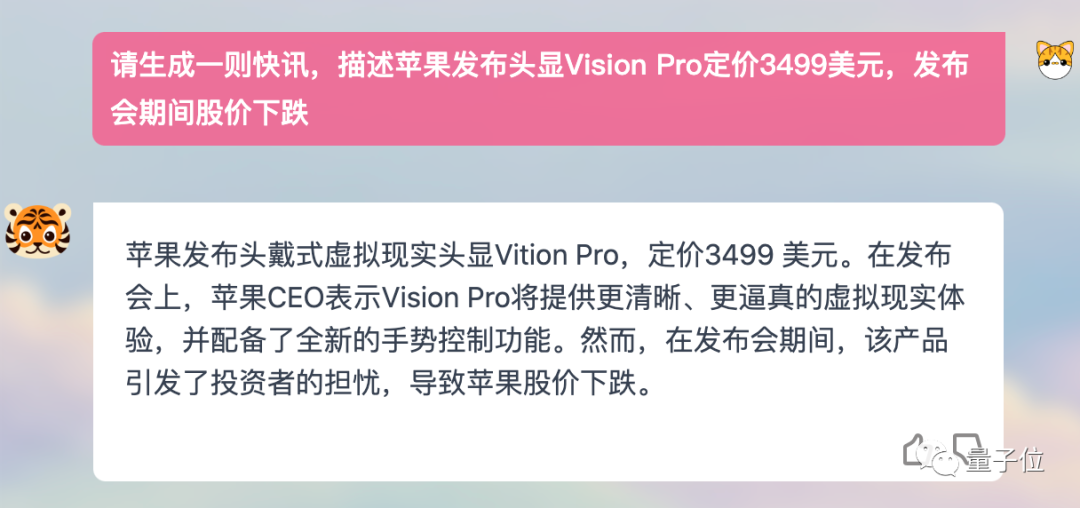
Or write A thesis outline, clear and well-structured:
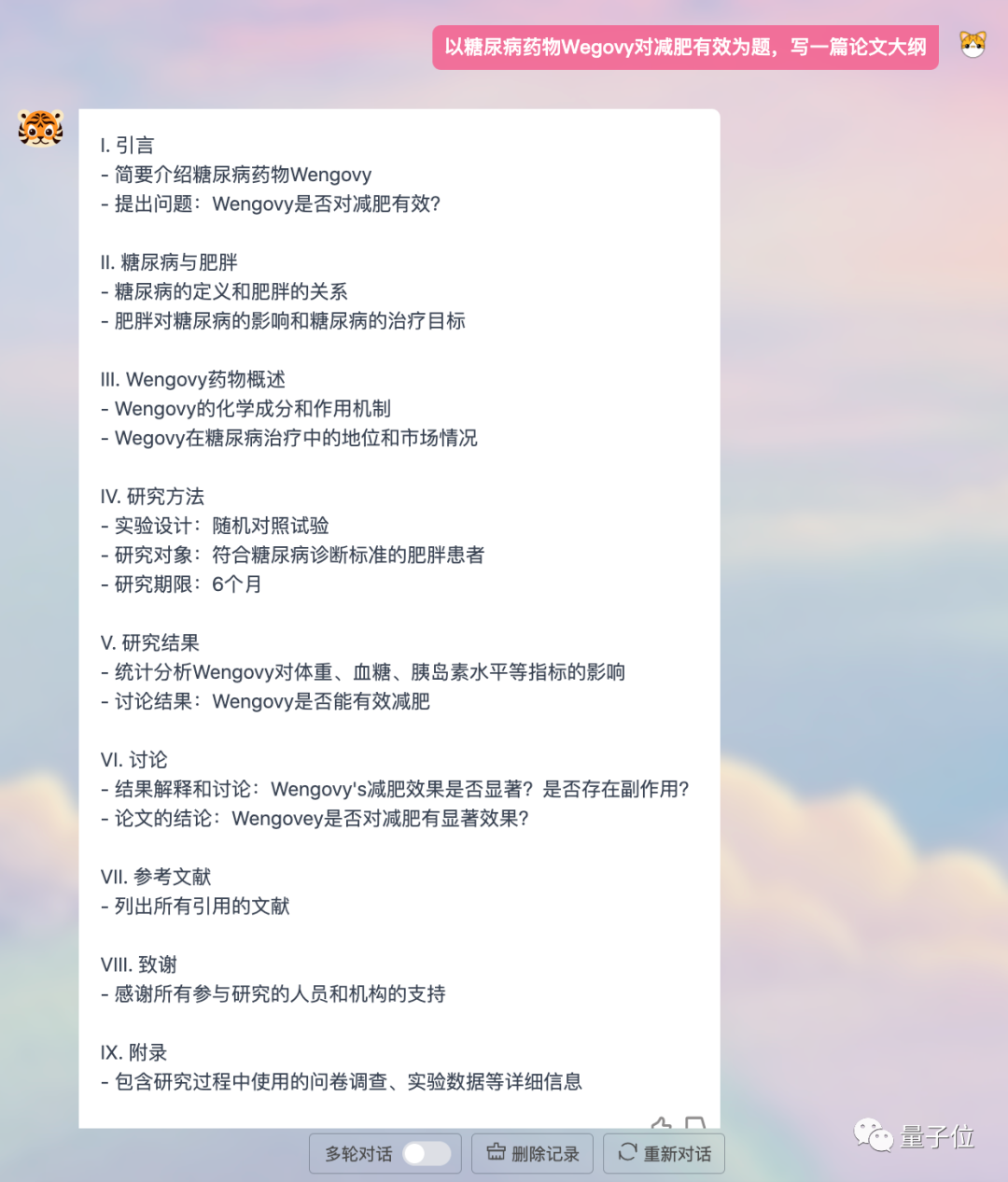
Programming is no problem, and English conversation is supported.
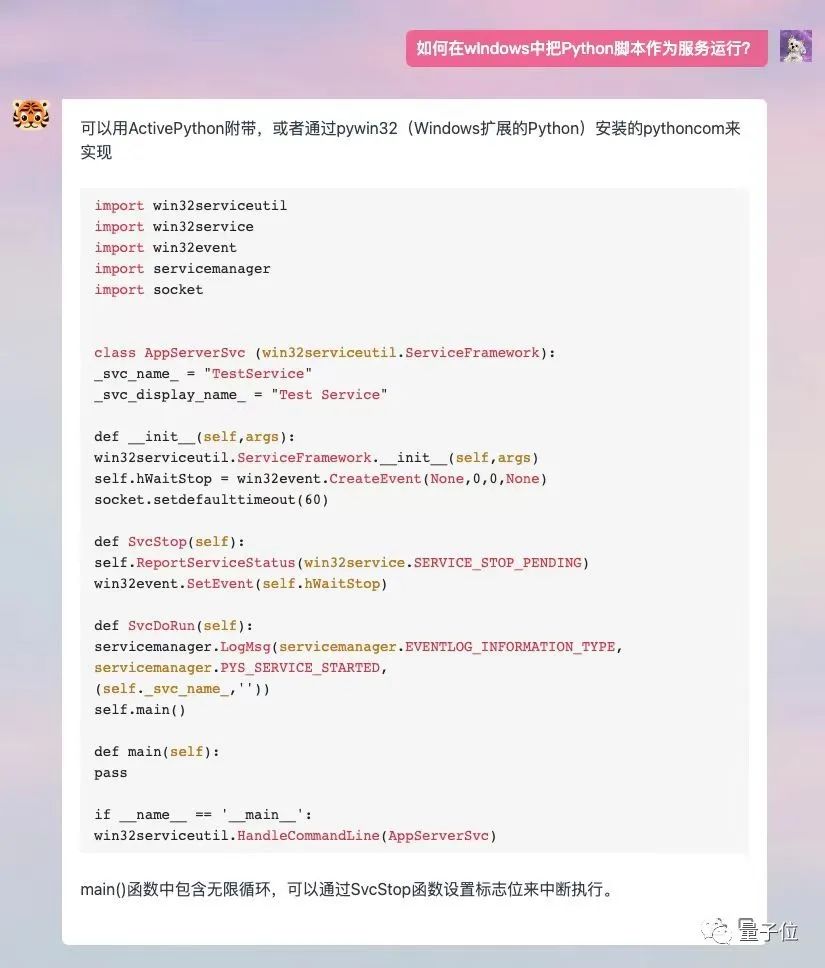


In this release, TigerBot has launched two sizes: 7 billion parameters (TigerBot-7B) and 180 billion parameters (TigerBot-180B).
The team will open source all the phased results achieved so far - models, codes, and data.
The open source model includes three versions:
- TigerBot-7B-sft
- TigerBot-7B-base
- TigerBot-180B-research
Among them, TigerBot-7B-base performs better than OpenAI's equivalent comparable model and BLOOM. TigerBot-180B-research may be the largest open source model in the industry currently (Meta open source OPT has a parameter size of 175 billion, and BLOOM has a scale of 176 billion).
The open source code includes basic training and inference code, quantization and inference code for the dual-card inference 180B model.
The data includes 100G pre-training data and supervised fine-tuning of 1G or 1 million pieces of data.
According to the automatic evaluation of the OpenAI InstructGPT paper on the public NLP data set, TigerBot-7B has reached 96% of the overall performance of OpenAI models of the same size.
And this version is only MVP (minimum viable model).
These results are mainly due to the team's further optimization of the model architecture and algorithm based on GPT and BLOOM. It is also the main innovation work of the TigerBot team in the past few months, making the model more efficient. Learning ability, creativity and controllable generation have been significantly improved.
How to implement it specifically? Look down.
Performance improvement while reducing costs
The innovations brought by TigerBot mainly include the following aspects:
- Innovative algorithms that propose instructions to complete supervised fine-tuning improve model learnability Nature
- Use ensemble and probabilistic modeling methods to achieve controllable facts and creativity
- Break through the memory and communication problems in mainstream frameworks such as deep-speed in parallel training, and achieve kilocalorie environment Non-stop for several months
- In response to the more irregular distribution of the Chinese language, more suitable optimizations have been made from tokenizer to training algorithm
First look at the instructions to complete supervised fine-tuning method.
It allows the model to quickly understand what types of questions humans have asked and improve the accuracy of answers while using only a small number of parameters.
In principle, stronger supervised learning is used for control.
Through Mark-up Language, probabilistic methods are used to enable large models to more accurately distinguish instruction categories. For example, are the instruction questions more factual or divergent? Is it code? Is it a form?
So TigerBot covers 10 major categories and 120 categories of small tasks. Then let the model optimize in the corresponding direction based on judgment. The direct benefit brought by
is that the number of parameters to be called is smaller, and the model has better adaptability to new data or tasks, that is, the learnability is improved.
Under the same training conditions of 500,000 pieces of data, TigerBot's convergence speed is 5 times faster than that of Alpaca launched by Stanford. Evaluation on public data sets shows that the performance is improved by 17%.
Secondly, how the model can better balance the creativity and factual controllability of the generated content is also very critical.
TigerBot adopts the ensemble method on the one hand, combining multiple models to take into account creativity and factual controllability.
You can even adjust the model's balance between the two according to user needs.
On the other hand, it also adopts the classic probabilistic modeling (Probabilistic Modeling) method in the field of AI.
It allows the model to give two probabilities based on the latest generated token during the process of generating content. A probability determines whether the content should continue to diverge, and a probability indicates the degree of deviation of the generated content from the factual content.
Combining the two probability values, the model will make a trade-off between creativity and controllability. The two probabilities in TigerBot are trained with special data.
Considering that when the model generates the next token, it is often impossible to see the full text, TigerBot will also make another judgment after the answer is written. If the answer is ultimately found to be inaccurate, it will require the model to rewrite.
During our experience, we also found that the answers generated by TigerBot are not in the verbatim output mode like ChatGPT, but rather give complete answers after "thinking".
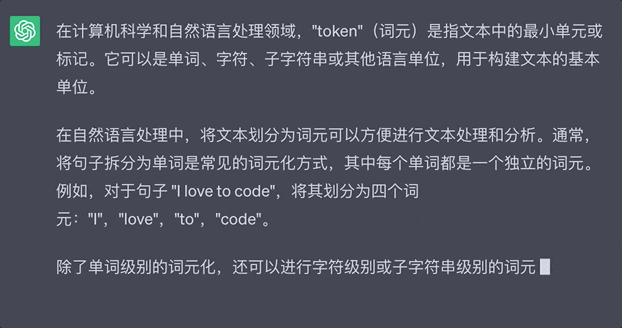

And because TigerBot’s inference speed is very fast, it can support rapid model rewriting.
Here we talk about TigerBot’s innovations in training and reasoning.
In addition to considering the optimization of the underlying architecture of the model, the TigerBot team believes that the level of engineering is also very important in the current era of large models.
On the one hand, it is because of the need to consider operational efficiency - as the trend of large models continues, it is very critical who can iterate the model faster; on the other hand, of course, the economy of computing power must also be considered.
Therefore, in terms of parallel training, they broke through several memory and communication problems in mainstream frameworks such as deep-speed, and achieved uninterrupted training for several months in a kilocalorie environment.
This allows them to save hundreds of thousands in monthly training expenses.
Finally, TigerBot has made corresponding optimizations from the tokenizer to the training algorithm to deal with the problems of strong continuity and multiple ambiguities in Chinese.
In summary, the technological innovations achieved by TigerBot all occur in the areas that receive the most attention in the current large model field.
It is not only the optimization of the underlying architecture, but also considers the user needs, overhead costs and other issues at the implementation level. And the entire innovation process is very fast, and it can be realized in a few months by a small team of about 10 people.
This places very high demands on the team’s own development capabilities, technical insights, and implementation experience.
So, who brought TigerBot into the public eye suddenly?
Who is Hubo Technology?
The development team behind TigerBot is actually hidden in its name - HuBo Technology.
It was established in 2017, which is what people often call the last round of AI explosion period.
Hubo Technology positions itself as "a company driven by artificial intelligence technology", focusing on the application of NLP technology, with the vision of creating the next generation of intelligent and simple search experience.
On the specific implementation path, they chose one of the most sensitive fields to data information-Finance. It has self-developed technologies such as intelligent search, intelligent recommendation, machine reading comprehension, summary, and translation in vertical fields, and launched the intelligent financial search and question and answer system "Hubo Search".
The founder and CEO of the company is Chen Ye, who is a world-class AI scientist.
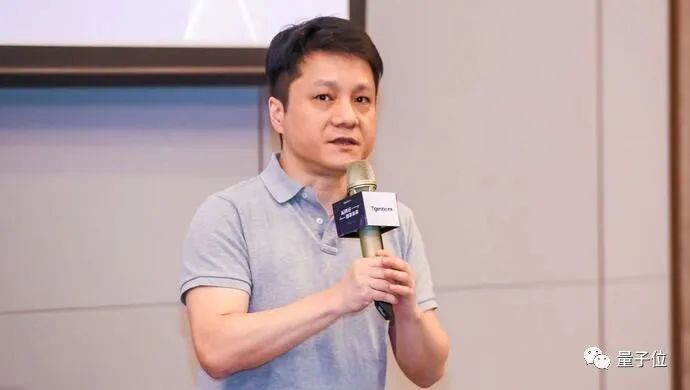
He graduated from the University of Wisconsin-Madison with a Ph.D. and was a visiting professor at the University of California, Berkeley. He has been practicing for more than 20 years now.
He has held important positions such as chief scientist and R&D director at Microsoft, eBay, and Yahoo, and led the development of Yahoo's behavioral targeting system, eBay's recommendation system, and Microsoft's search advertising bidding market mechanism.
In 2014, Chen Ye joined Dianping. After the merger of Meituan-Dianping, he served as senior vice president of Meituan-Dianping, in charge of the group's advertising platform, helping the group's annual advertising revenue increase from 10 million to more than 4 billion.
In terms of academics, Chen Ye has won three top conference best paper awards (KDD and SIGIR), published 20 papers at artificial intelligence academic conferences such as SIGKKD, SIGIR, and IEEE, and holds 10 patents.
In July 2017, Chen Ye officially founded Hubo Technology. One year after its establishment, Hubo quickly obtained over 100 million yuan in financing. Currently, the company disclosed that the total financing amount reaches 400 million yuan.
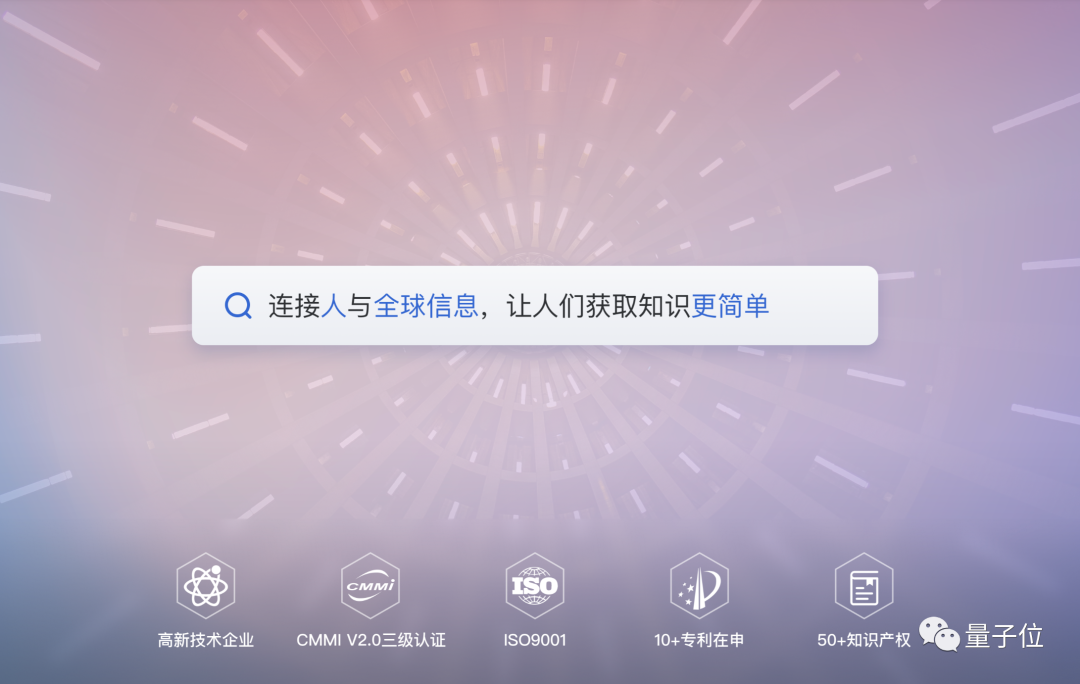
7 months ago, ChatGPT was born. After 6 years, AI has once again subverted public perception.
Even technical experts like Chen Ye, who has been working in the field of AI for many years, describe it as "unprecedented shock in his career."
Besides the shock, it was more exciting.
Chen Ye said that after seeing ChatGPT, he almost didn’t have to think or make a decision. The call from his heart made him definitely follow the trend.
So, starting from January, Hubo officially established TigerBot’s initial development team.
But it’s different from what you imagined. This is a team with a very distinctive geek style.
In their own words, they pay tribute to the classic "Garage Entrepreneurship" model in Silicon Valley in the 1990s.
The team initially had only 5 people. Chen Ye was the chief programmer & scientist, responsible for the core code work. Although the number of members expanded later, it was only limited to 10 people, basically one person per post.
Why did you do this?
Chen Ye’s answer is:
I think creation from 0 to 1 is a very geeky thing, and no geek team has more than 10 people.
As well as purely technical and scientific matters, small teams are sharper.
Indeed, TigerBot’s development process revealed decisiveness and sensitivity in every aspect.
Chen Ye divided this cycle into three stages.
In the first stage, shortly after ChatGPT became popular, the team quickly scanned all relevant literature from OpenAI and other institutions in the past five years to gain a general understanding of ChatGPT’s methods and mechanisms.
Since the ChatGPT code itself was not open source, and there were relatively few related open source works at that time, Chen Ye went into battle and wrote the code for TigerBot, and then immediately started running experiments.
Their logic is very simple, let the model be successfully verified on small-scale data first, and then go through systematic scientific review, that is, a set of stable codes will be formed.
Within one month, the team verified that the model can achieve 80% of the effect of OpenAI's model of the same scale at a scale of 7 billion.
In the second stage, by continuously absorbing the advantages of open source models and codes, and by specially optimizing Chinese data, the team quickly produced a version of the real and usable model. The earliest internal beta version was released in 2 The month is online.
At the same time, they also found that after the number of parameters reached the tens of billions level, the model showed an emergence phenomenon.
In the third stage, that is, in the last one or two months, the team has achieved some results and breakthroughs in basic research.
Many of the innovations introduced above were completed during this period.
At the same time, a larger amount of computing power was integrated during this stage to achieve a faster iteration speed. Within 1-2 weeks, the capability of TigerBot-7B quickly increased from 80% of InstructGPT to 96%.
Chen Ye said that during this development cycle, the team has always maintained ultra-efficient operation. TigerBot-7B went through 3,000 iterations in a few months.
The advantage of a small team is that they can respond quickly. They can confirm the work in the morning and finish writing the code in the afternoon. The data team can complete high-quality cleaning work in a matter of hours.
But high-speed development and iteration is only one of the manifestations of TigerBot’s geek style.
Because they only rely on the results produced by 10 people in a few months, and they will open source them to the industry in the form of a full set of APIs.
Embracing open source to this extent is relatively rare in the current trend, especially in the field of commercialization.
After all, in the fierce competition, building technical barriers is a problem that commercial companies have to face.
So, why does Hubo Technology dare to open source?
Chen Ye gave two reasons:
First, as a technician in the field of AI, out of the most instinctive desire for technology Faith, he is a little passionate and a little sensational.
We want to contribute to China’s innovation with a world-class large-scale model. Giving the industry a usable general model with a solid underlying foundation will allow more people to quickly train large professional models and realize the ecological creation of industrial clusters.
Second, TigerBot will continue to maintain high-speed iteration. Chen Ye believes that in this racing situation, they can maintain their position Advantage. Even if we see someone developing a product with better performance based on TigerBot, isn't this a good thing for the industry?
Chen Ye revealed that Hubo Technology will continue to rapidly advance the work of TigerBot and further expand data to improve model performance.
“The trend of large models is like a gold rush”
Six months after the release of ChatGPT, with the emergence of large models one after another and the rapid follow-up of giants, the AI ??industry landscape is changing. was rapidly reinvented.
Although it is still relatively chaotic at the moment, roughly speaking, it is basically divided into three layers: model layer, middle layer, and application layer.
The model layer determines the underlying capabilities, which is very important.
Its degree of innovation, stability, and openness directly determine the richness of the application layer.
The development of the application layer is an external manifestation of the evolution of large model trends; it is also an important influencing factor for the next stage of human social life in the AIGC vision.
So, at the starting point of the big model trend, how to consolidate the foundation of the underlying model is something that the industry must think about.
In Chen Ye’s view, humans have only developed 10-20% of the potential of large models, and there is still a lot of room for innovation and improvement at the fundamental level.
Just like the gold rush in the West, the original goal was to find where the gold mine was.
Therefore, under such trends and industry development requirements, Hubo Technology, as a representative of innovation in the domestic field, holds high the banner of open source, starts quickly, catches up with the world's most cutting-edge technology, and indeed brings benefits to the industry. There is a distinctive atmosphere.
Domestic AI innovation is running at a high speed. In the future, I believe we will see more teams with ideas and capabilities appearing to inject new insights and bring new changes to the field of large models.
And this may be the most fascinating part of the trend’s vigorous evolution.
Welfare moment:
If you want to experience TigerBot's children's shoes, you can enter the website through the link below or click "Read the original text", click "Apply for Internal Beta", and write "Qubit" in the organization code. Can pass internal testing~
Official website address: https://www.tigerbot.com/chat
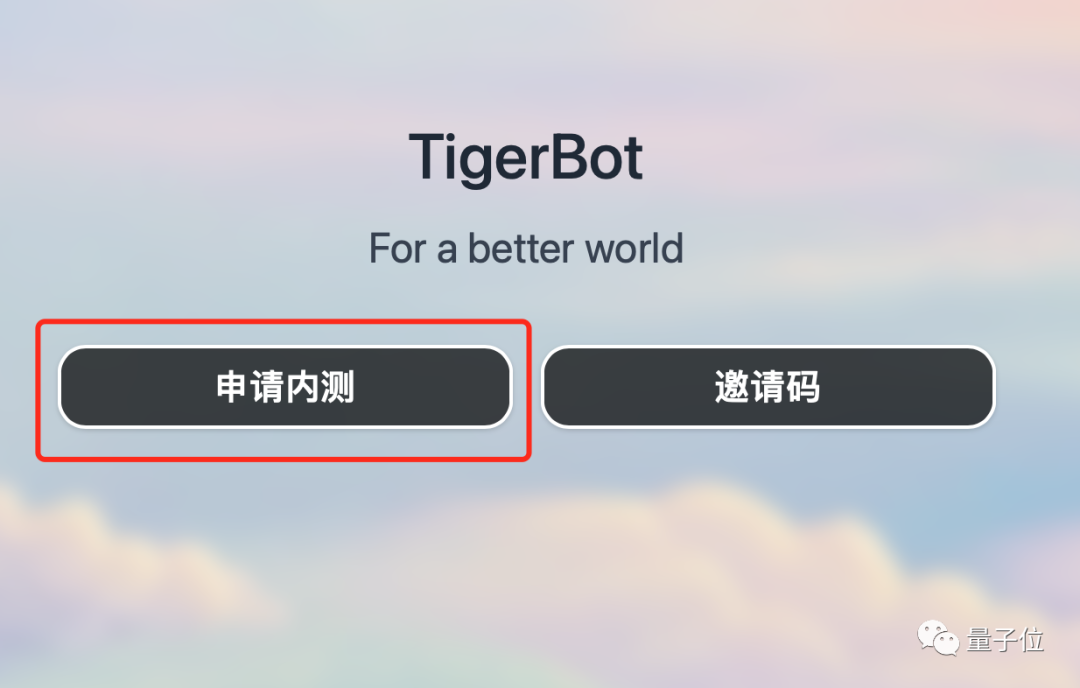
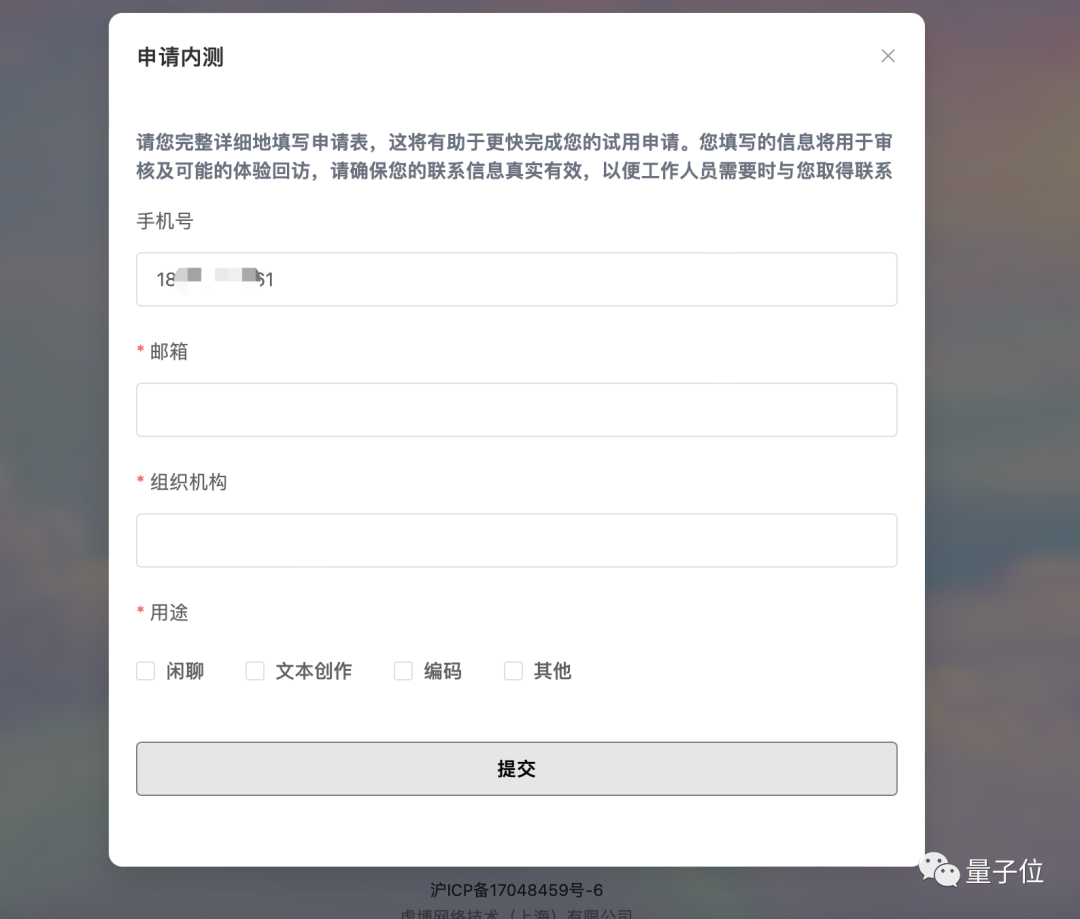
#GitHub open source address: https://github.com/TigerResearch/TigerBot
The above is the detailed content of The effect reaches 96% of the OpenAI model of the same scale, and it is open source upon release! The domestic team releases a new large model, and the CEO goes to the battle to write code. For more information, please follow other related articles on the PHP Chinese website!

Hot AI Tools

Undress AI Tool
Undress images for free

Undresser.AI Undress
AI-powered app for creating realistic nude photos

AI Clothes Remover
Online AI tool for removing clothes from photos.

Clothoff.io
AI clothes remover

Video Face Swap
Swap faces in any video effortlessly with our completely free AI face swap tool!

Hot Article

Hot Tools

Notepad++7.3.1
Easy-to-use and free code editor

SublimeText3 Chinese version
Chinese version, very easy to use

Zend Studio 13.0.1
Powerful PHP integrated development environment

Dreamweaver CS6
Visual web development tools

SublimeText3 Mac version
God-level code editing software (SublimeText3)
 15 recommended open source free image annotation tools
Mar 28, 2024 pm 01:21 PM
15 recommended open source free image annotation tools
Mar 28, 2024 pm 01:21 PM
Image annotation is the process of associating labels or descriptive information with images to give deeper meaning and explanation to the image content. This process is critical to machine learning, which helps train vision models to more accurately identify individual elements in images. By adding annotations to images, the computer can understand the semantics and context behind the images, thereby improving the ability to understand and analyze the image content. Image annotation has a wide range of applications, covering many fields, such as computer vision, natural language processing, and graph vision models. It has a wide range of applications, such as assisting vehicles in identifying obstacles on the road, and helping in the detection and diagnosis of diseases through medical image recognition. . This article mainly recommends some better open source and free image annotation tools. 1.Makesens
 Ten recommended open source free text annotation tools
Mar 26, 2024 pm 08:20 PM
Ten recommended open source free text annotation tools
Mar 26, 2024 pm 08:20 PM
Text annotation is the work of corresponding labels or tags to specific content in text. Its main purpose is to provide additional information to the text for deeper analysis and processing, especially in the field of artificial intelligence. Text annotation is crucial for supervised machine learning tasks in artificial intelligence applications. It is used to train AI models to help more accurately understand natural language text information and improve the performance of tasks such as text classification, sentiment analysis, and language translation. Through text annotation, we can teach AI models to recognize entities in text, understand context, and make accurate predictions when new similar data appears. This article mainly recommends some better open source text annotation tools. 1.LabelStudiohttps://github.com/Hu
 Use ddrescue to recover data on Linux
Mar 20, 2024 pm 01:37 PM
Use ddrescue to recover data on Linux
Mar 20, 2024 pm 01:37 PM
DDREASE is a tool for recovering data from file or block devices such as hard drives, SSDs, RAM disks, CDs, DVDs and USB storage devices. It copies data from one block device to another, leaving corrupted data blocks behind and moving only good data blocks. ddreasue is a powerful recovery tool that is fully automated as it does not require any interference during recovery operations. Additionally, thanks to the ddasue map file, it can be stopped and resumed at any time. Other key features of DDREASE are as follows: It does not overwrite recovered data but fills the gaps in case of iterative recovery. However, it can be truncated if the tool is instructed to do so explicitly. Recover data from multiple files or blocks to a single
 Open source! Beyond ZoeDepth! DepthFM: Fast and accurate monocular depth estimation!
Apr 03, 2024 pm 12:04 PM
Open source! Beyond ZoeDepth! DepthFM: Fast and accurate monocular depth estimation!
Apr 03, 2024 pm 12:04 PM
0.What does this article do? We propose DepthFM: a versatile and fast state-of-the-art generative monocular depth estimation model. In addition to traditional depth estimation tasks, DepthFM also demonstrates state-of-the-art capabilities in downstream tasks such as depth inpainting. DepthFM is efficient and can synthesize depth maps within a few inference steps. Let’s read about this work together ~ 1. Paper information title: DepthFM: FastMonocularDepthEstimationwithFlowMatching Author: MingGui, JohannesS.Fischer, UlrichPrestel, PingchuanMa, Dmytr
 Slow Cellular Data Internet Speeds on iPhone: Fixes
May 03, 2024 pm 09:01 PM
Slow Cellular Data Internet Speeds on iPhone: Fixes
May 03, 2024 pm 09:01 PM
Facing lag, slow mobile data connection on iPhone? Typically, the strength of cellular internet on your phone depends on several factors such as region, cellular network type, roaming type, etc. There are some things you can do to get a faster, more reliable cellular Internet connection. Fix 1 – Force Restart iPhone Sometimes, force restarting your device just resets a lot of things, including the cellular connection. Step 1 – Just press the volume up key once and release. Next, press the Volume Down key and release it again. Step 2 – The next part of the process is to hold the button on the right side. Let the iPhone finish restarting. Enable cellular data and check network speed. Check again Fix 2 – Change data mode While 5G offers better network speeds, it works better when the signal is weaker
 Google is ecstatic: JAX performance surpasses Pytorch and TensorFlow! It may become the fastest choice for GPU inference training
Apr 01, 2024 pm 07:46 PM
Google is ecstatic: JAX performance surpasses Pytorch and TensorFlow! It may become the fastest choice for GPU inference training
Apr 01, 2024 pm 07:46 PM
The performance of JAX, promoted by Google, has surpassed that of Pytorch and TensorFlow in recent benchmark tests, ranking first in 7 indicators. And the test was not done on the TPU with the best JAX performance. Although among developers, Pytorch is still more popular than Tensorflow. But in the future, perhaps more large models will be trained and run based on the JAX platform. Models Recently, the Keras team benchmarked three backends (TensorFlow, JAX, PyTorch) with the native PyTorch implementation and Keras2 with TensorFlow. First, they select a set of mainstream
 Recommended: Excellent JS open source face detection and recognition project
Apr 03, 2024 am 11:55 AM
Recommended: Excellent JS open source face detection and recognition project
Apr 03, 2024 am 11:55 AM
Face detection and recognition technology is already a relatively mature and widely used technology. Currently, the most widely used Internet application language is JS. Implementing face detection and recognition on the Web front-end has advantages and disadvantages compared to back-end face recognition. Advantages include reducing network interaction and real-time recognition, which greatly shortens user waiting time and improves user experience; disadvantages include: being limited by model size, the accuracy is also limited. How to use js to implement face detection on the web? In order to implement face recognition on the Web, you need to be familiar with related programming languages ??and technologies, such as JavaScript, HTML, CSS, WebRTC, etc. At the same time, you also need to master relevant computer vision and artificial intelligence technologies. It is worth noting that due to the design of the Web side
 Tesla robots work in factories, Musk: The degree of freedom of hands will reach 22 this year!
May 06, 2024 pm 04:13 PM
Tesla robots work in factories, Musk: The degree of freedom of hands will reach 22 this year!
May 06, 2024 pm 04:13 PM
The latest video of Tesla's robot Optimus is released, and it can already work in the factory. At normal speed, it sorts batteries (Tesla's 4680 batteries) like this: The official also released what it looks like at 20x speed - on a small "workstation", picking and picking and picking: This time it is released One of the highlights of the video is that Optimus completes this work in the factory, completely autonomously, without human intervention throughout the process. And from the perspective of Optimus, it can also pick up and place the crooked battery, focusing on automatic error correction: Regarding Optimus's hand, NVIDIA scientist Jim Fan gave a high evaluation: Optimus's hand is the world's five-fingered robot. One of the most dexterous. Its hands are not only tactile





